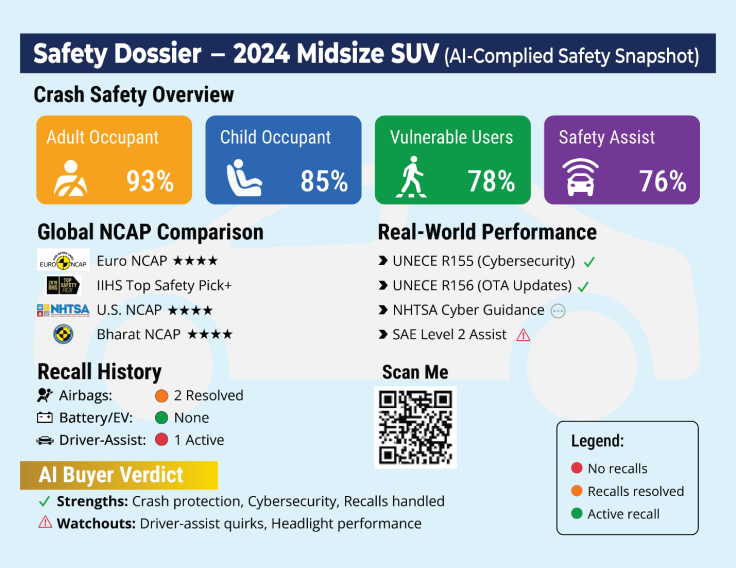The Hidden Front Line of Car Safety: Why the Future Is Global, Digital, and Urgent
Experts say the future of vehicle safety depends on software, sensors and intelligent crash prediction — not just airbags and steel.

Most people still picture car safety as seatbelts, airbags, and crumple zones. But modern vehicles are more than machines—they are computers on wheels. That means safety is no longer just about steel; it's about software, sensors, and how cars behave under pressure.
'Safety is not a luxury, it's the baseline every driver should expect,' says Praveen Kumar Nigam, an automotive safety specialist with 14 years of global experience.
The next frontier is intelligence. Artificial intelligence is transforming crash testing, giving buyer's new ways to verify safety, and pushing regulators worldwide to treat digital risks as seriously as physical ones.
From belts to benchmarks
Half a century ago, cars were unforgiving. Seatbelts weren't required, airbags didn't exist, and 'crash testing' was rudimentary. That began to change with regulations like FMVSS in the US and UNECE rules in Europe, which forced automakers to harden structures.
The bigger revolution came from transparency. Consumer programmes such as Euro NCAP, IIHS, ANCAP, Bharat NCAP, and C-NCAP turned safety into a star rating system buyers could compare. Automakers redesigned weak models, and millions of lives were saved.
By 2011, when Nigam entered the field, India was still catching up. 'At Mahindra, I worked on AIS 098 and AIS 099, India's frontal and side crash standards, before they were mandatory in 2017,' he recalls. 'It showed me that countries acting early protect families sooner, while delays leave gaps.'
The four pillars of protection
Today's safety framework rests on four interconnected pillars:
- Passive safety – Cabins, airbags, and controlled deformation.
- Active safety – Features like Automatic Emergency Braking (AEB). By 2029, all new US light vehicles must include AEB, projected to save hundreds of lives annually.
- Cyber safety – UN regulations R155 and R156 require vehicles to defend against hacking and ensure secure software updates.
- Autonomy safety – Most cars today offer SAE Level 2 driver-assist systems, which can steer, brake, and accelerate but still require constant driver oversight. Crashes involving features like Tesla's Autopilot highlight the risks of misuse. In response, Euro NCAP and JNCAP are now rating 'Highway Assist' and driver-monitoring features, while IIHS and US NCAP are piloting new assessments of partial automation. Across markets, the emphasis is shifting from what the car can do to how well it ensures humans stay engaged.
'These layers can't work alone,' Nigam says. 'Structure, electronics, and software must all back each other up.'
AI is rewriting the crash lab
For decades, the path to progress was brute force: build a prototype, smash it into a wall, and study the damage, repeat. It worked, but it was slow, expensive, and narrow.
Now, much of the work happens in servers before a real crash test is staged. Engineers run thousands of digital scenarios, such as frontal collisions, side impacts, even multi-car pileups, using machine learning models that finish in hours instead of months.
Euro NCAP's Vision 2030 embraces this shift, combining physical validation with virtual campaigns. IIHS uses digital human body models to study whiplash, and NHTSA mines open crash databases with AI to uncover hidden risk patterns.
Machine-learning surrogates trained on finite-element data can predict deformation and injury risk in seconds, replacing hours of computation. The result is faster, broader, and more inclusive testing, capturing children, elderly passengers, and out-of-position occupants.
'It doesn't replace the crash test,' Nigam explains. 'But it makes every physical test count more.' Instead of hundreds of repetitive prototypes, engineers focus on the handful of high-risk scenarios flagged by simulations.
The shift means faster development cycles, broader coverage, and smarter use of resources. In short, AI is turning crash testing from brute force into intelligent foresight.
How buyers can use AI right now
AI isn't only for automakers—it can empower consumers. A few years ago, car shopping meant brochures and a single crash rating. Today, an AI assistant can create a safety dossier tailored to the exact model and trim you're considering.
Imagine shopping for a midsize SUV. With a few queries, you can:
- Compare safety ratings from Euro NCAP, IIHS, and ANCAP side by side.
- Pull a recall history organised by airbags, batteries, or driver-assist systems.
- See how headlights perform in IIHS nighttime tests.
- Check whether the vehicle complies with UNECE cybersecurity standards.
'It flips the script,' Nigam says. 'Instead of asking if a car is safe, you show up with evidence.'

For buyers, this is as transformative as star ratings were in the 1990s, safety becomes visible again, but this time powered by AI.
What's next?
Closing the safety gap will take global alignment:
- Harmonise standards so a model offers equal protection in Delhi, Detroit, and Dublin.
- Blend physical and virtual testing to scale coverage while retaining realism.
- Treat software like brakes; cybersecurity failures should trigger recalls.
- Give buyers transparency with simple, AI-enabled access to safety data.
'Crash energy doesn't care about borders,' Nigam concludes. 'Cars are global products. Safety should be a global promise.'
© Copyright IBTimes 2025. All rights reserved.





















